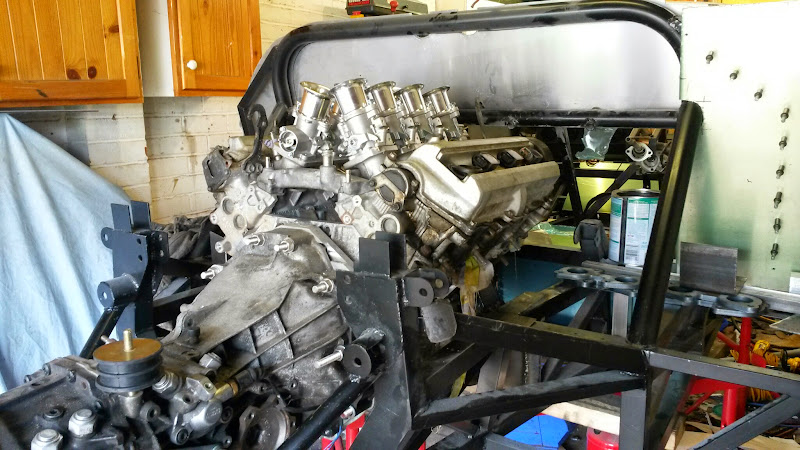I’m currently in the middle of looking at suspension geometry but there is somewhat of an issue… that of tyre choice. So I’ve decided to tie down what size wheels and tyres I will be using.
I’ve already decided my wheels are going to be 8in wide front, 10in wide rear (or there abouts). I’m going to pick the most common cheapest suitable sizes. Tyre diameters are from here, tyre availability and prices are taken from blackcircles.
There are many reasons behind this logic.
- More choice, the more original GT40 replicas are restricted to only a couple of tyres. With many manufacturers I’ve got the choice between going sticky and short lived or hard and long lived.
- Cheaper. While running costs are not going to be cheap and I’m not going just on price the difference in 10mm width (or 1in dia) can be 100’s of £, see the difference below in the cost of a 275/40R17 vs a 285/40R17, 1cm wider but a new pair of 285/40R18 will cost £200-£400 extra!
- Cheaper! Mentioned twice because if rear tyres are £100ea I’m not going to worry about ruining a set on a trackday etc. OTOH I may cry if they are £350ea!
- Availability. If I get a puncture I want to be able to go to a garage and get a replacement. I don’t want to be in the position of having one tyre maker who do one run a year and there being no stock locally (if at all) or just not available any more (Ducati 906 Paso anyone?)
So onwards, lets look at what the originals used vs the modern SPF recreation. Now these are only one example as the GT40 used many different sizes in it’s race life.
Front originally approximately a 250/60R15 and a 225/50R15 or 225/60R15 used as a modern replacement.
Rear originally approximately a 325/60R15 and a 295/50R15 or 275/60R15 used as a modern replacement.
So firstly I’m going to ignore the non-common (and original) sizes and work out the diameter of the remaining.
225/50R15 = 606mm
225/60R15 = 651mm
295/50R15=676mm
Lets look at tyre availability…
225/50R15 – two tyres, £80-£95ea
225/60R15 – eight tyres, £56-300ea
295/50R15 – one tyre, £375ea
OK, original sizes are out. Fronts are cheap enough but no range and only one rear!
I want to keep the same “look” with the rears larger than the fronts so want to keep roughly 50mm (2in) larger on the back than the front.
Lets look at 16in wheels, firstly lets work out the recommended sizes (no stretch here!) using a tyre size calculator. For the front 8in wheel we have an ideal of 225 to 235. So lets keep it as a 225 for now. On the rear we have an ideal of 265-275. Keeping the width and overall dia (nearly) the same the choices are a 225/45R16 (608.9mm, 4 tyres available, £96-£131ea) or a 225/55R16 (653.9mm, 74 tyres available!, £41-£135ea) for the front and er nothing for the rear, nearest can get is a 255/50R16 (661mm, 1 available, £387.29ea).
Onto 17in wheels, again the 8in front is recommended 225-235 and the rear 265-275 (max 285) here we have a choice of three, nothing that is near 606mm, nearest is a fair bit smaller. Choices are 225/35R17 (589.3mm, 3 tyres, £100-£152ea), 225/40R17 (611.08, 36 tyres, £68-£132), 225/45R17 (634mm, 166 tyres available!!!!, £44-£122ea), 225/50R17 (656.8mm, 116 tyres available, £51-£142ea). Rear tricky again choice of 255/40R17 (635.8mm, 21 tyres available, £73-£151), 255/45R17 (661.3mm, 7 tyres available, £143-£191), 265/40R17(643.8mm, 1 tyre, £131.59), 275/40R17 (651.8mm, 1 tyre, £174.09), 285/40R17 (659.8mm, 2 tyres, £268.59-£371.59ea),
Finally 18in wheels, same widths still. front 235/30R18 (598.2mm, 0 tyres), 225/35R18, (614.7mm, 9 tyres, £106-£140ea), 225/40R18 (637.2mm, 90 tyres, £48-£99), 235/35R18 (621.7mm, 0 tyres) . Rear 275/35R18 (649.7mm, 14 tyres £94-£238), 285/35R18 (656.7mm, 13 tyres, £156-£245), 265/40R18 (669.2mm,18 tyres, £106-£243), 275/40R18 (677.2mm, 10 tyres £179-£243), 285/40R18 (686.7mm, 1 tyre, £346), 255/40R18 (661.2mm, 31 tyres, £79-£187)
OK. We now have a lot of data and the chosen results are…..
Front 225/40R17. Not the cheapest, not the most available but in a pinch I could fit a 225/45R17 (gain 11mm front height) or a slightly wide 235/40R17. The 18in wheels just didn’t have small enough tyres available.
Rear 255/40R18. A larger wheel on the back mostly as more suitable sizes. Slightly narrow and the cheapest tyre this time but spot on sized at 50mm larger diameter than the front and as I’m “only” going for ~300hp a 255 rear will be fine.



